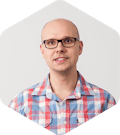How to build a marketplace app
In this extensive guide, Sharetribe’s senior full-stack developer takes you through the steps of developing a marketplace app. From building the backend with essential features to designing and creating a web or mobile marketplace app.
Marketplaces are growing.
In 2021, marketplace sales took 67% of all global eCommerce. By 2027, it's expected that third-party sales through online marketplaces will be the largest and fastest-growing retail channel worldwide.
Skeptics might say that this is all happening because of the Amazons of the world and there's no room for startups anymore.
They'd be wrong.
At least if you believe investors, who seem to think the marketplace revolution is just getting started. The venture fund FJLabs (whose portfolio includes names like Alibaba, Airbnb, and Uber) says they evaluate 40–50 pitches from marketplace founders every week.
A big trend—and this is interesting news for a new startup founder—is verticalization. Large "everything for everyone" platforms like Amazon, eBay, or Thumbtack are facing more and more competition from small players that focus on a niche.
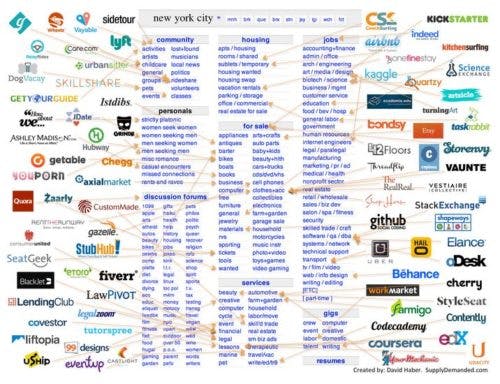
Wherever you see a large marketplace incumbent is an opportunity for you to identify an underserved audience group and build a business specifically for them.
In this guide, I assume you have already found a great marketplace idea, validated it, and figured out a way to monetize it. Now, let's get that idea into the world and build a marketplace app.
Before you start developing, there are a few things worth discussing briefly.
If you're still in the idea stage and not sure if you're going to start building a marketplace for real, I recommend checking out our 10-step guide to creating a marketplace. It talks a lot more about the business side of things, from validating your idea to finding a good monetization strategy and growing and scaling your business.
Marketplaces can be divided into types based on a few criteria. Let’s look at the main types from the point of view of marketplace app development.
Marketplace offering type. What your providers sell impacts the features your app needs. If you're building a product marketplaces like Etsy or a website like Amazon probably need inventory management and a shipping integration. A rental marketplace (a website like Airbnb, for example) or a service marketplace (a website like Fiverr) needs to have a booking calendar, location search, and user profiles (but has no use for a shopping cart or shipping). On-demand marketplaces (like Uber) need a powerful map that shows the real-time location of service providers.
Audience type. Different audiences have different needs. Peer-to-peer marketplace users appreciate complete user profiles, two-sided reviews, and smooth, secure payments. On B2C marketplaces, you need features that help your professional sellers manage their business. B2B marketplaces usually have complicated transaction flows and need even more custom functionality.
Booking flow type. How you design your marketplace booking flow has a big impact on the features your app will need. Do customers search for providers, or do the customers post jobs and providers bid on them? Are prices fixed or negotiated? Are bookings scheduled or happen on-demand? One way to understand booking flow types is to look at how different marketplaces relate to pricing, location, and booking schedule.
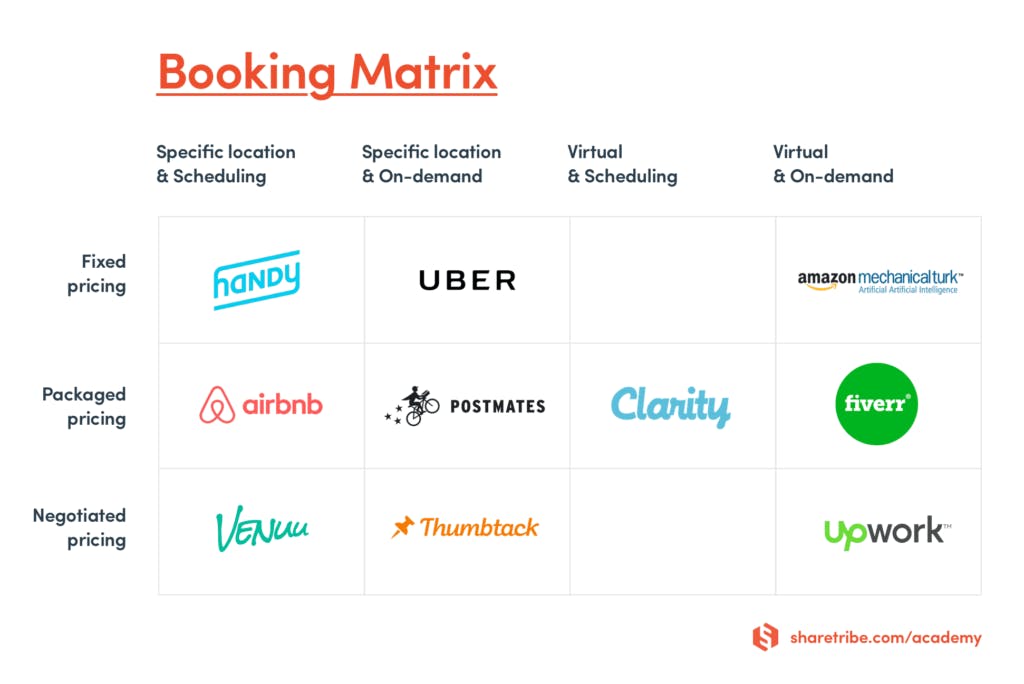
This step is important to consider carefully because building the transaction flow will take a big part of your development time. This is where using Sharetribe can make a difference: it offers a pre-built yet fully customizable transaction engine.
In addition to the categories above, there are many other ways to distinguish marketplace type, such as by horizontal/vertical focus, by marketplace business model, or by management approach. These distinctions affect how you build individual features but not the fundamentals of your marketplace. So, I’ll leave them out of the discussion and move on to outlining the building blocks of a marketplace app.
Your marketplace app will consist of three fundamental components.
The marketplace backend. The backend is your marketplace’s beating heart. It’s where user-generated data is stored in a database and where your transaction engine with all user functionality lives. In chapter two of this article, I’ll list all the essential features your backend should power and outline the general project flow of building a marketplace app from scratch.
The Admin UI. Think of your admin UI as something between your marketplace backend and your user interface. It reports all your marketplace activity and lets you monitor and manage users, notifications, messages, transactions, and reviews. The admin features need to be built in the backend, and they’ll need a graphical user interface, too.
The User Interface. The UI is the branded and beautifully designed website or mobile app that your users interact with. You need different sections and features for sellers and customers, listing pages, user profiles, and content pages. The User Interface can be a web application (used through the browser with a desktop, tablet, or phone) or a native mobile application (downloaded through an app store).
In Sharetribe, we offer you the first two (fully-featured marketplace backend and a powerful admin console) out of the box. We also offer a web application that's connected to our backend, which you can launch completely no code. Your no-code web app works on our customizable marketplace template. Familiarizing yourself with the template and using it as a basis can help speed up the UI development of your mobile app, but you can also build a completely custom user interface for either web or mobile.
Marketplaces are some of the toughest businesses to build. They are much slower to show traction than traditional startups. Successful founders very often had to iterate on their ideas and business models before the business started working (lots of examples of this in this podcast episode).
At the same time, marketplace websites are complex beasts. Airbnb today employs over 1,200 engineers.
If you start building the perfect marketplace experience from scratch, the chances are that:
- The project will take you several months
- You'll end up building something your users don't want.
So, even if you have the skills to develop a really amazing platform, don't start from your ideal version. Start with something that lets you test your idea with real people really quickly.
The first version can be extremely simple. It only needs to do two things really well:
- Solve your suppliers’ core problem.
- Solve your customers’ core problem.
Some folks have even started with just a Google Sheet and lots of manual work.
Even if you have the coding skills, your time as a founder is your most valuable asset. You should spend that on validating your business, not on building something you're not sure works.
I'm naturally a bit biased, but I really recommend Sharetribe for this stage. You can get started with our no-code builder and get your marketplace MVP live in a matter of hours. Later, you can custom-develop unique features on top of the basics—which is a much better use of your time than coding the basics from scratch.
(We also have good content that helps you compare some key Sharetribe competitors and building a marketplace MVP with Wordpress, if you're interested in looking into alternatives.)
With these prerequisites in mind, let's look at the features that a marketplace app needs in 2024.
What is a must-have and what is a nice-to-have will, of course, depend on your unique marketplace idea. And, as I said earlier, I do recommend taking the MVP approach and cutting back on features for the first version (unless, of course, you're using Sharetribe, in which case you get all of these out of the box ;)).
Working with marketplace development for nearly a decade, I’ve found this list of functionalities to be a pretty common starting point for marketplace apps:
- Account & user profile management
- Listing management
- Site search & discoverability
- Transaction process
- Payment integration
- Booking & availability management
- Admin features
- Marketing & communications
- Hosting, monitoring & security
Next, I'll talk a bit more about what exact features can go under each of these functionalities.
Features needed:
- Sign in
- Login
- Email integration
- Verify email
- Forgot password
- Change email
- Ban account
- Delete account
- GDPR-compliance
- Social logins (Facebook, Google, Twitter, LinkedIn, Github, etc.)
- User profiles (First name, last name, bio)
- Additional profile information
- Upload profile picture
On a marketplace, both sellers and buyers typically have accounts and user profiles. You’ll need a standard sign-up and profile creation flow for both user groups. You’ll also need to store the account info in a way that is secure and compliant with local legal requirements.

Features needed:
- Basic listing information: title, description, price
- Additional fields
- Update and delete listings
- Close listings
- Draft listings
- Listing approval
- Upload listing images
- Listing geolocation
- Pricing information
- Listing variations
Listings are, essentially, the product that your marketplace offers. You’ll want them to be informative, appealing, and complete so you can maximize conversions.
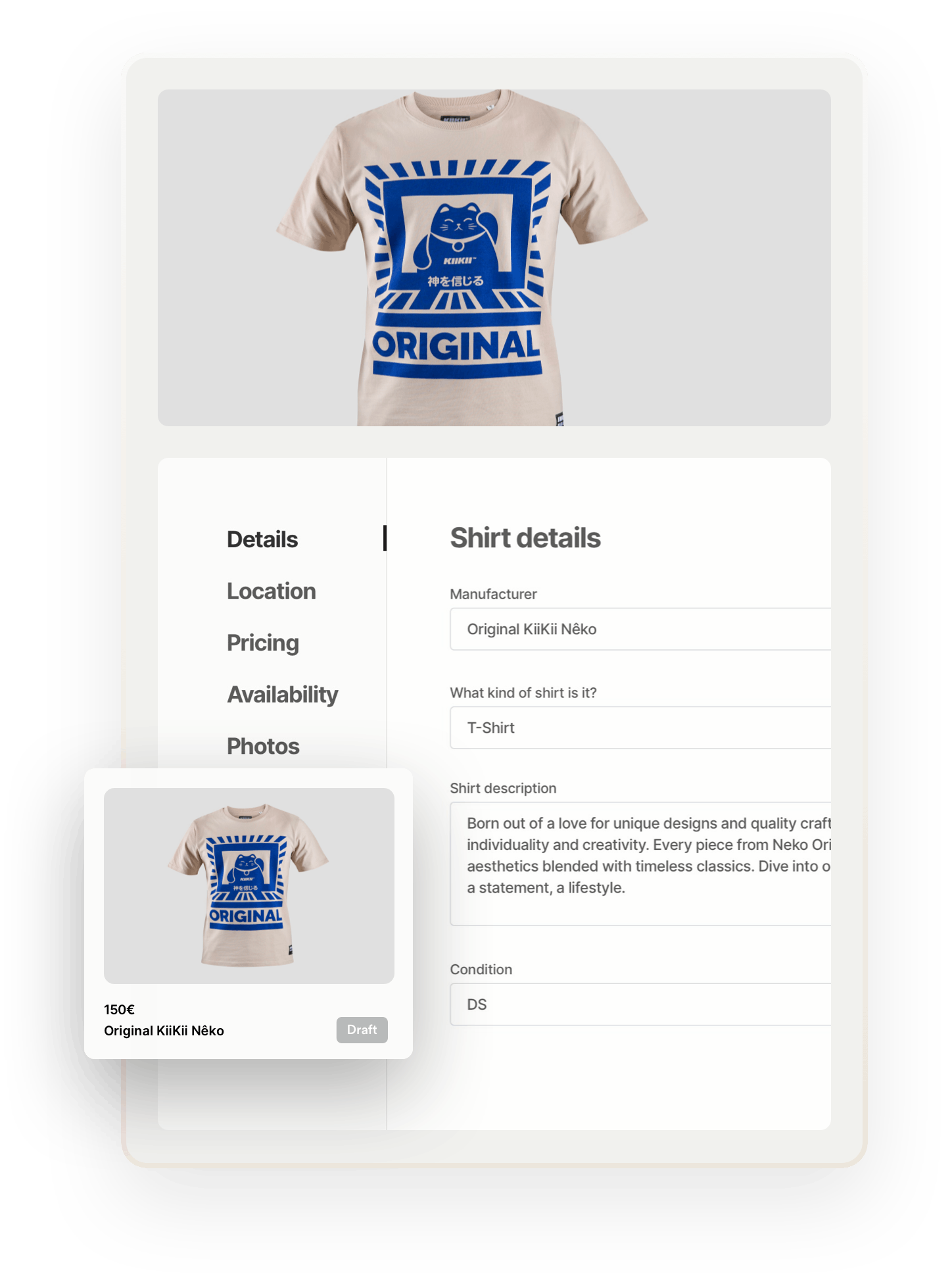
Features needed:
- Map
- Location search
- Location auto-complete
- Listing categories
- Filtered search
- Keyword search
- Availability search
If marketplace customers won’t find what they’re looking for on your marketplace, none of your other features really matters. Here’s a thorough article on how to design you design your marketplace search.

- On-site messaging tools
- Notifications (email integration/SMS integration/push notifications)
- Pricing options (fixed/dynamic/seasonal/negotiation, add-ons)
- Cancellation policies
- Automatic expiration
- Charging a commission
- Delayed payouts and refund management
- Invoicing
- Reviews after transaction
- Taxes
- PDF receipts
Designing a transaction flow means defining the stages of user interaction (e.g. making a booking request, accepting it, and leaving a review) and transaction outcomes (e.g. successful, rejected, or cancelled).
Instead of designing and implementing just one type of process, I strongly recommend building a “transaction engine” where multiple different versions of your transaction process can progress at the same time. More on this later in this article.
Features needed:
- Choose a payment gateway with support for the geographies, payment methods, and currencies you need
- Build an integration with the help of Redirect URLs and Return URLs, Webhooks, or API access.
- Seller-onboarding flow that fulfills Know Your Customer (KYC) requirements
- Authorize and capture payments
- Handle 3D Security / Strong Customer Authentication
- Refund
- Delayed payout
- Split payment between the seller and the marketplace
Marketplace payments are subject to all kinds of regulation that traditional eCommerce avoids. With eCommerce, there's only one entity that receives payouts: the shop owner. On a marketplace, all the sellers receive payouts.
In the world of online payments, paying money in is easy. Payouts are hard.
Payouts are subject to all kinds of regulation, anti-money-laundering legislation, and fraud-prevention measures. Global payouts are especially challenging. To make things even more complicated, most marketplaces also need to split every payment from a customer. One part of that payment goes to the seller as a payout, and another to the marketplace as the service fee.
Because of all this complexity, I strongly recommend that you find a payment gateway to integrate with that specializes in marketplaces. Generalist payment processors are unlikely to give you all the features that you need. Sharetribe, for example, comes with an integration to Stripe Connect, but it also lets you build a custom integration to any other payment provider you choose.
Here's our complete guide to marketplace payments, and here's an article that compares the top marketplace payment providers.

Features needed:
- Booking calendar for buyers
- Availability management calendar for sellers
- Support for different time zones
- Handle Daylight Savings changes etc.
- Stock management
- Seats
- Ability to filter search by availability
The marketplace with the best-quality supply is the marketplace that wins customers. To make your marketplace defensible against competitors, give your sellers powerful features to manage their offerings.
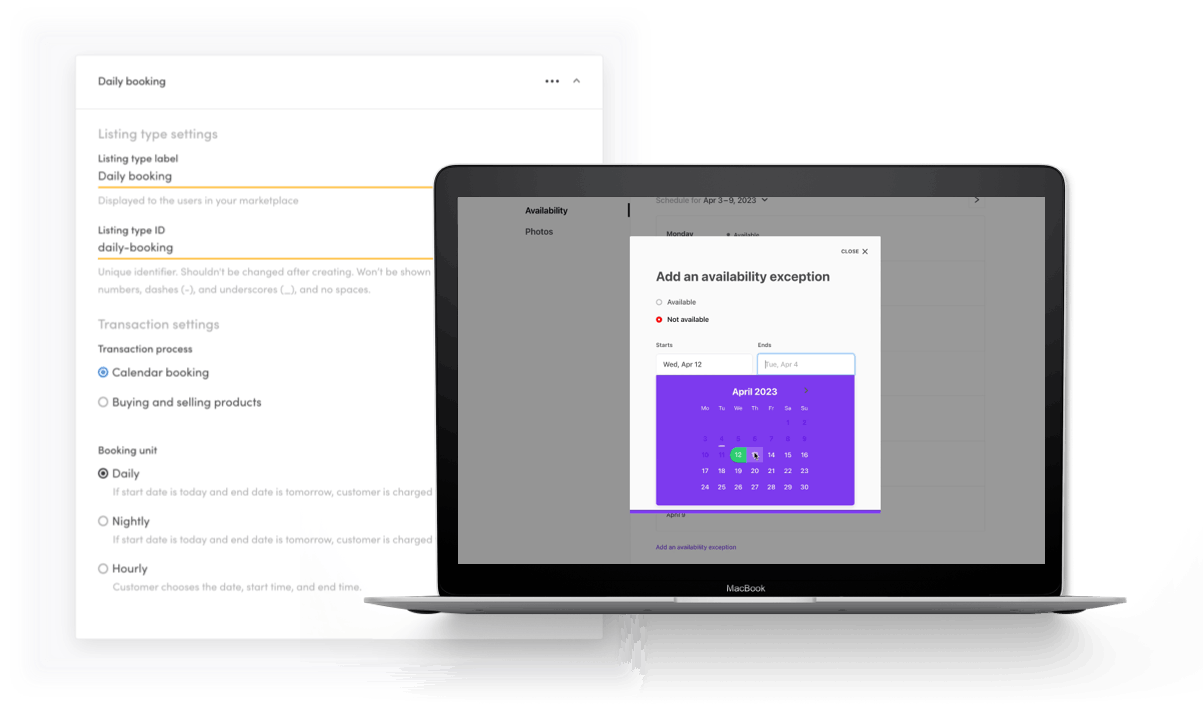
Features needed:
- Intuitive Admin UI
- User search
- User account status
- User management
- Managing products or services that are being sold
- Access to all user-generated content
- Access to messages
- Ability to manage transactions
- Notification management
- And more.
On the best marketplaces, the admin console is almost like an app of its own. Your admin features help you manage activity, learn about your users, and identify improvement areas where you can boost conversion, transaction quality, and retention.

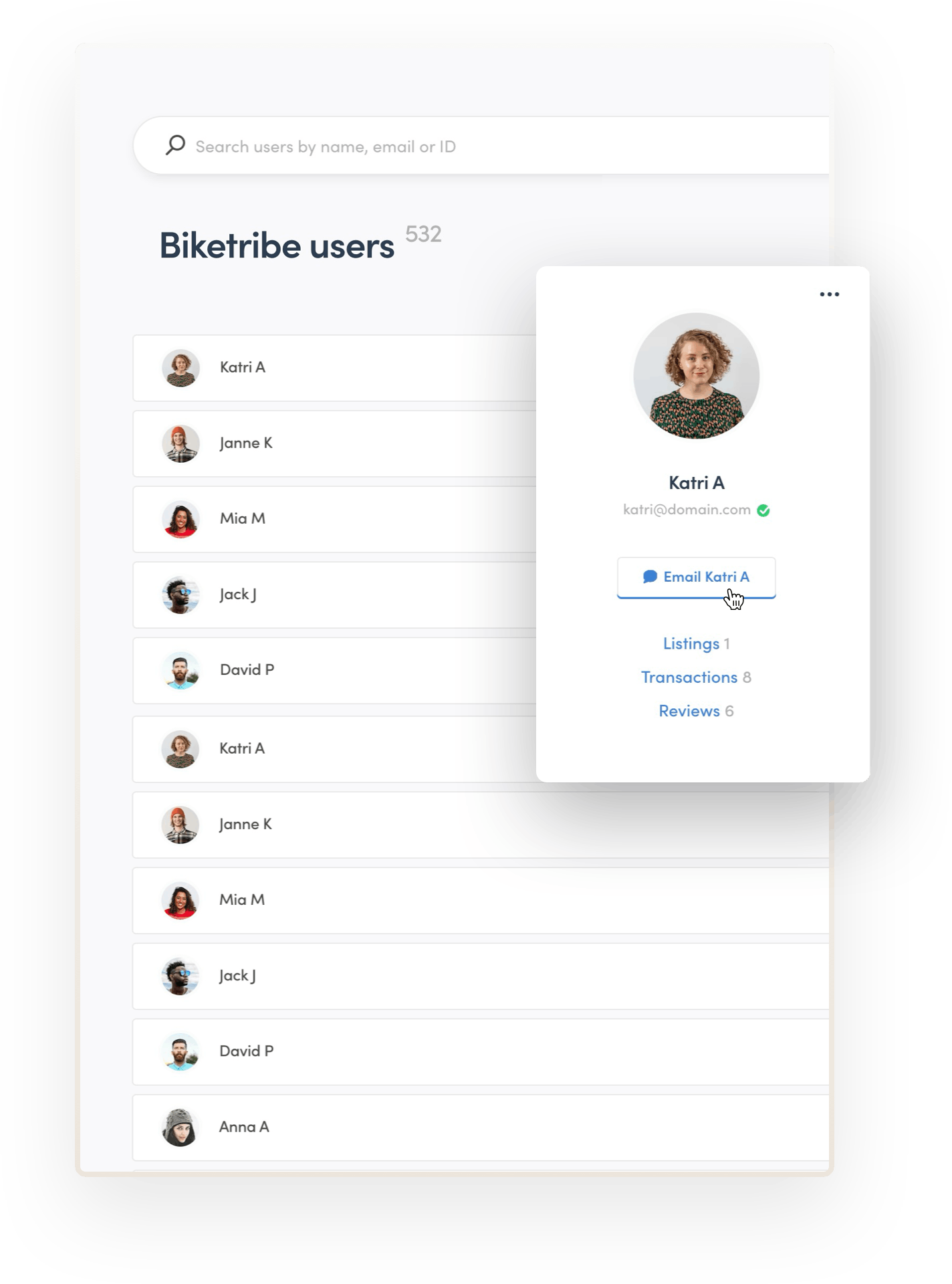
Features needed:
- Hosting (e.g. AWS or Heroku)
- Maintenance
- Performance monitoring
- Error tracking
- Logging
- Alerting when the app is unavailable / performing slowly
- Audit logs
- Security and privacy
- Scalable data storage
- Auto-scaling (or at least ability to manually scale your infrastructure in case of traffic spikes)
On a marketplace that reaches a meaningful scale, maintenance work is daily. Sooner or later, you’ll need a full-time DevOps person to manage your architecture and maintain and update configurations and integrations. You’ll also need a robust security and performance monitoring system in place. If something goes wrong at 2 AM, someone needs to get an alert, get up, and handle the situation.
You’ll also need an infrastructure with auto-scaling support, or at least the ability to manually scale up your servers quickly in the case of traffic spikes. If your marketplace goes viral but your site is unavailable because your servers can't handle the load, you might miss a once-in-a-lifetime chance.
Needless to say, backend hosting, monitoring, and security are always included in Sharetribe, at whatever scale your business reaches.
Marketplaces are complicated websites. Developing your marketplace app, even in its first MVP stage, is a big undertaking if done from scratch. The steps, usually, are these:
- Choose your marketplace tech stack: coding language, web development framework, main database, etc.
- Set up the framework and database
- Design the database schema
- Implement user accounts
- Implement listing management
- Implement a basic listing search
- Design and model the initial transaction process
- Implement reviews
- Implement availability management
- Build your admin UI
- Build your marketplace app UI as you're building the backend
- Launch
In my experience, getting to step 12 likely means 6–12 months of development. This article won’t give you a full practical tutorial on how to move the development project forward step by step—that would take a book. Instead, my goal is to help you plan your project in terms of time, tech stack, and development skills.
At the end of this chapter, I'll also show you how to get all of this (and more) live with Sharetribe in a matter of days, rather than several months.
Let's get started!
Choose a language. Any language that is suited for website development works with building the backend of your marketplace. Ruby, PHP, JavaScript, Python, Java, Clojure... pick your poison. To get started fast, choose the one you are familiar with. Or if this is a project for you to learn a new language, be prepared that building takes more time.
Choose a framework. It's a good idea to use a web development framework. There are lots of boilerplate features you need to build for the marketplace backend that the frameworks handle for you, including:
- Authentication and web security
- HTTP request/response handling
- HTTP request validation
- Routing
- Templating
- Database connection management and data migrations
- Background job processing
- Error handling
- Logging.
If you go with Ruby, Rails is an obvious choice. With PHP, Laravel is currently the most popular one. For JavaScript you might want to have a look at Express.js and for Python, Django is a widely-used option.
Choose the main database. A relational SQL database is a safe choice. The frameworks tend to have good support for SQL databases out of the box. Choose e.g. PostgreSQL or MySQL. It's also good to check if your hosting provider has any preferences. For example, Heroku prefers PostgreSQL.
Choose a search engine. You’ll probably need an advanced search for your marketplace, so using a search engine might make sense. Elasticsearch is great; that's what we use for Sharetribe. But do check what your database is capable of. For example, PostgreSQL supports full-text search and extensions such as PostGIS that add support for location-based queries. Even if you start without a search engine, you may need to introduce one at some point.
Choose a fast in-memory key-value store. In addition to your main database, you may need to use a fast in-memory key-value store for caching and storing data that doesn't really belong to your main database: authentication tokens, background job work queues, and so on. Redis is a popular in-memory data store for this purpose. We use it with Sharetribe.
Choose an email-sending service. You will probably want to use a dedicated email service to to deliver emails reliably – ie. prevent them from landing in your users’ spam folders. Choose between SendGrid (our choice for Sharetribe), Mailgun, or Amazon SES, for example.
Choose a hosting provider. Heroku is the easiest to get your marketplace app up and running, but you can also choose Amazon Web Services, Microsoft Azure or Google Cloud, for example.
Start by building the skeleton of your marketplace application. Follow the instructions of your chosen framework to install and configure the framework for your marketplace project.
Next, install your database. Finally, set up a framework for automated tests so that it's ready to be used when you start building actual features.
Time to think about your marketplace data architecture. How will information be stored, searched, accessed, and displayed?
In reality, designing the database schema isn’t a step in the process that can be done beforehand. Instead, this is something you’ll need to take into account with every new feature that you add.
However, in the beginning, it's good to design how to model the most essential entities of a marketplace and store them in the database. In the case of marketplaces, the most essential entities are users, listings, and transactions.
Build a user account management with sign-up, login, and password reset capabilities.
There are some SaaS services like Auth0 that offer account management. However, the cost may be an obstacle – a Developer plan for 5,000 Monthly Active Users costs 114$ per month.
What are the key criteria your customers will use to search for relevant listings? Building a great discovery flow isn’t easy, so I suggest you start with the basics. For example, for a marketplace like Airbnb, searching listings based on location, and capacity (number of beds) is critical. Availability search is great, but pretty difficult to implement, so I recommend scoping that out from the first version.
Later, as you learn more about how your users interact with your marketplace, you can improve the search. For example by adding an availability search and keyword search.
Take a moment to design your marketplace's initial transaction process. Answer questions like:
- What are the steps the customers and providers go through?
- When does the payment happen?
- Do the providers confirm customers' requests, or does this happen automatically (a so-called "instant book" process).
- How about declined requests and disputes?
- What if the provider doesn't reply? When does the transaction expire?
- Do you plan to add a review feature? At what point of the transaction can the customer and provider review each other? Will the review by one party be published to the other party before the other party has reviewed them?
- At which points in the transaction process do you want to send automatic notifications?
- What do you do if a payment fails, or if the payout to the seller fails? Both of these can occur sometimes for various reasons: banks might decline credit cards, a third-party payment system integration may have hiccups, there might be a bug in your code that causes you to calculate your commission wrong, and so on.
Then, plan how you’ll model the transaction process in your database. How do you ensure consistency and move only valid transitions from transaction state to another state? For example, you can’t move a transaction from state `requested-by-customer` to state `waiting-for-provider-to-deliver` without first going through the state `customer-paid`, right?
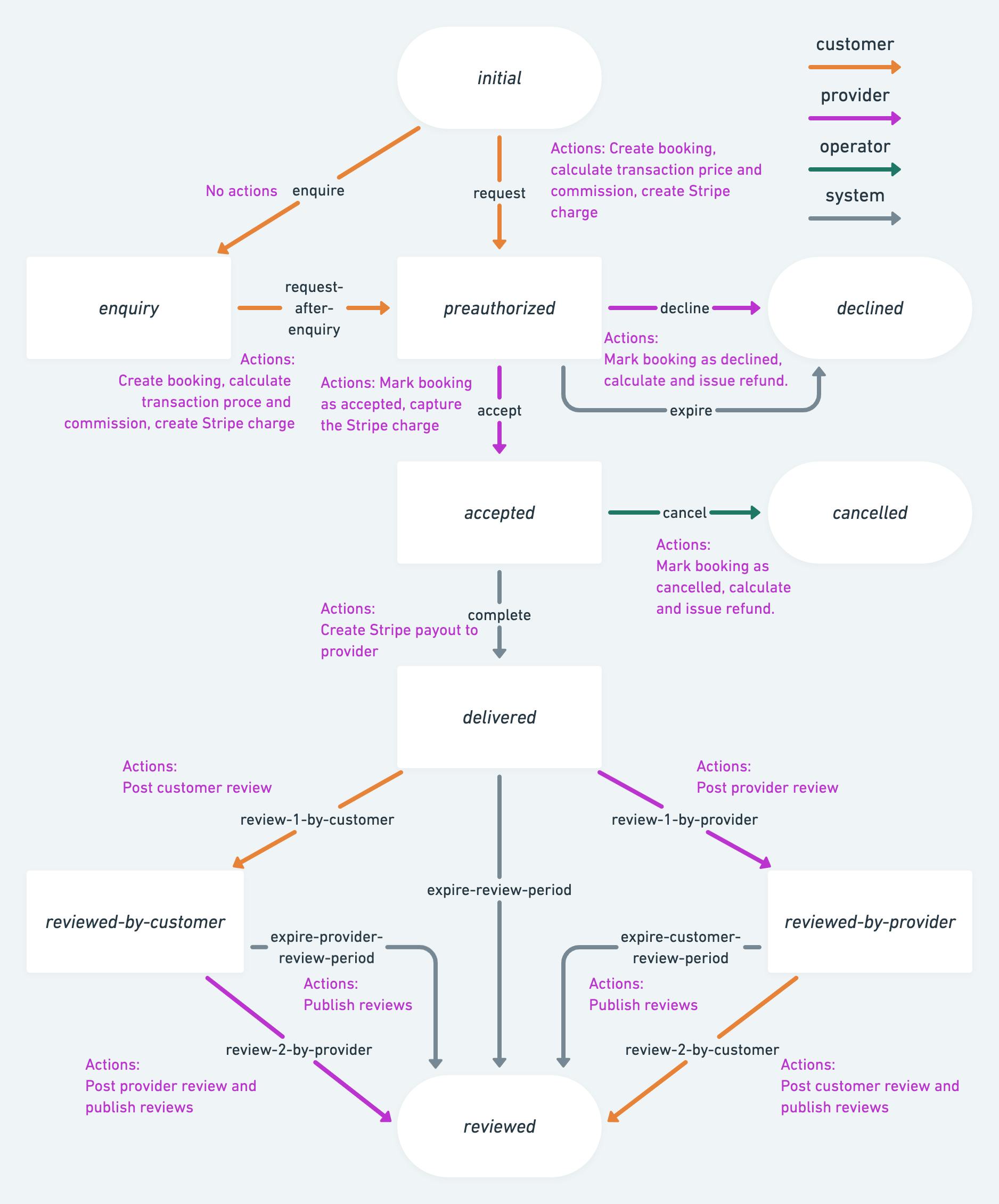
A State machine library like Xstate can be quite useful here. And again, I can’t stop myself from recommending the documentation for Sharetribe's transaction process – I think you’ll find a few ideas worth stealing for your marketplace there.
An important point worth repeating: Plan how to model the transaction process so that it allows changes.
As your marketplace gets more and more users and transactions, you’re guaranteed to get more ideas for your transaction process. For example, you might first implement your transaction process so that the money is paid out to the provider right after the booking ends (in the case of rental or service marketplace). Later, you might notice that it takes some time for a customer to file a dispute if they’re unhappy. So, you decide to add a new step for customers to mark the transaction completed before the money is paid out to the provider.
If you're building a mobile application, the ability to have multiple transaction versions running together becomes even more important. Consider the earlier example of asking customers to mark the transaction completed. That's a change that needs a new UI component, a "Mark as completed" button.
For web applications, you can just add the new button and deploy the changes. But for mobile apps, you need to publish a new version to the app store and wait for your users to update their apps. For a while, you will have users with two different versions: the old version without the "Mark as completed" button, and the new version with the button. Existing transactions need to be able to go through even with the old version.
So, one more time for the people in the back: Future-proof your marketplace by building your transaction engine in a way that supports iteration and updates. In other words, make sure that old processes and new versions can coexist for as long as transactions that were initiated in the old version are ongoing.
Do customers only review the providers, or do providers also review the sellers? At what point in the transaction? Are the reviews given in stars or ratings, or is there a text field? Do you also ask for a review that won’t be published for users but only used to monitor and improve your marketplace? And so on. Design a review feature that helps you add trust and social proof to your marketplace.
Build a booking calendar or stock management system for your providers. The purpose of availability management is to
- Prevent double-bookings by blocking the availability the moment a customer makes a booking.
- Help customers search the offering based on availability.
- Help providers run their listings easily – this is a value proposition that locks your providers in to your platform.
Depending on your marketplace type, availability management will be based on time, day, or stock. If time-based, remember to account for time zones and changes due to Daylight Saving Time.
What parts of your marketplace activity do you need to monitor? How do you control user accounts and user access? How do you moderate user-generated content?
On successful, large-scale marketplaces, the Admin UI is a powerful web application in itself. In the early stages, you can start with the basics and improve the admin UI as your marketplace grows and the admin workload increases.
All the functionality you build for your marketplace app backend will naturally need the corresponding UI components your users will interact with.
If you’re building your backend to be used through an API, you might build the backend features first before working on the frontend. But far more often—and definitely if you’re building the front end and the backend using the same framework, like Rails—it makes sense to build them simultaneously through an iterative process.
Working on both the front end and the back end at the same time will help you cut work into meaningful parts and keep motivated as you see your marketplace slowly coming to life.
More importantly, building the front end for your features will give you important feedback about how to design the features under the hood. I speak from experience. Many times, we’ve improved the functionality of a Sharetribe backend feature thanks to something we’ve figured out while building the UI for that feature for Sharetribe Web Template.
At this point, you’re probably about 6–12 into your marketplace project (depending on the size of your team, of course). It’s go time.
The final remaining steps are setting up hosting for your backend and frontend. And make sure you have sufficient monitoring, error tracking, and logging in place—you’ll thank yourself later.
Buy a domain, point your DNS to your site, and go live. Congratulations—you’re the founder, owner, and operator of an online marketplace business.
Speaking of launch, this is a step where the line between what is marketing and what is product development is blurry. Here’s an article with some advice about planning and executing a product launch and a marketing launch.
Our goal with developing Sharetribe is to make building a customized marketplace app 90% faster than building from scratch. (And 90% cheaper than if you’d outsource that development.)
The features I listed in the previous chapter are marketplace essentials. They pose no competitive advantage. In 2024, they're pretty much table stakes.
But as you can see from the building process I outlined, coding all of them from scratch will take several months to build from one full-time developer. The return on that investment would be, to a large degree, a set of powerful but basic features that users nowadays take for granted.
In my experience, that time is much more wise to spend on crafting a killer UI or building one or two custom features that make your marketplace stand out. Or just on plain old marketing and user acquisition.
Sharetribe offers you all of the features I listed off the shelf. A fully customizable transaction engine, secure online payments, a powerful admin console, and more. If Sharetribe's default functionality serves your marketplace's needs, you can launch a marketplace website without any coding.
You can also freely develop unique features, designs, or third-party integrations on top of the essentials, thanks to Sharetribe’s set of APIs. We’ve put in a lot of attention to making Sharetribe a joy to work with for developers. You can kick the tires and start developing with Sharetribe with a 14-day free trial of our Build plan.
One more thing before I conclude this promotional bit. Sharetribe offers a website marketplace app template that you can launch without any coding and customize further; find it on Github. Using the template as a basis for custom development speeds up the UI development side considerably. I’ll introduce the Template next as I go through the steps of developing a marketplace app (on web and mobile) with Sharetribe.
Let’s assume, for the sake of the rest of this article, that my subtle marketing message got you convinced, and you decided to build your marketplace app with Sharetribe. Here’s how that process would go down for the web application:
- Choose your tech stack for the front end (Sharetribe offers you a marketplace back end API and admin UI)
- Download the Sharetribe Web Template
- Set up your development environment
- Start customizing your marketplace app
- Launch
Some more information on each step next. Jump here to see the process for mobile app development.
Sharetribe gives you a full-blown marketplace backend API and an admin UI (which we call Console), so you only need to build the website front end.
The first step in choosing your tech stack, the second is creating a free Sharetribe trial.
Sharetribe Web Template is built with JavaScript, React, and Node.js. If those are your languages of choice, you can set up the first version of your marketplace and test Sharetribe's functionality in Console and in your Test environment. If the features work for your MVP, you can subscribe and start onboarding users. Creating a web app with Sharetribe can be as simple as that.
And if you choose to build custom functionality, the Template is definitely the fastest way to get your first (or second) version launched.
If you prefer to build the front end from scratch, you can do so in any language you want. You can build the front end with languages such as PHP or Ruby. Sharetribe provides a JSON HTTP API that can be called from any language.
If you build the front end from scratch with JavaScript, I recommend using the Sharetribe SDK for JavaScript, as it implements some features regarding authentication, data serialization, and so on.
Everything else—database, email, search, backend-hosting, etc.—is included in Sharetribe, so you’re all set to start customizing the user-facing side of your marketplace.
By far the most first-time founders launch their marketplace MVP with Sharetribe's no-code builder, without doing any custom development yet. That's a good strategy, because then they have good data points from real users to decide what the most important feature additions are.
Let's assume, for the sake of this article, that you are building unique functionality on top of Sharetribe, which means custom development.
Sharetribe Web Template is a fantastic starting point for any type of marketplace, whether your idea is about product sales, services, or rentals. The template has support for both inventory management and time-based availability management, and you can easily configure it to fit your marketplace's basic concept. The layout is responsive and looks great on all devices.
The Template is built using modern and widespread web technologies, such as React, Redux, CSS Modules, Webpack, and so on. If you are familiar with these technologies, you should be able to familiarize yourself with the code base rather quickly.
Here are some more details about estimating the level of difficulty of custom-developing with Sharetribe.
Here, you can download the Sharetribe Web Template code.
The first thing to do is to set up a development environment locally. To do so, go to your Console where you got access when you created your Sharetribe account. Follow the step-by-step instructions on the Console front page.
If you have any issues, you can always contact our support team.
All done? You have your development environment up and running! So, at this stage, you have officially completed steps 1–11 from my list of marketplace app development stages.
Follow the steps in this tutorial to start customizing your marketplace app to your liking. The branding, the data storage, and the transaction process.
Depending on the level of customization your idea needs, this step usually takes marketplace developers from a few weeks to two to three months.
Time to launch your business. Buy a domain and hosting for your frontend, for example from Heroku. Get a subscription for Sharetribe. You’re set! 🎉
No need to worry about anything else – your Sharetribe subscription includes hosting for your backend, and we’ll also monitor errors and traffic spikes on your behalf. You can focus on running your business, building new things, and implementing new features we build for Sharetribe on the regular (check out our past releases if you’re interested).
Consumers continue to spend more and more time on their mobile devices each year. In 2020, the average was over 3 hours every day. In 2019, mobile traffic already accounted for over 65% of the total traffic to eCommerce sites.
Most marketplaces start off with a web app and build a mobile app once the business has started to show traction, but for some concepts, a mobile app is needed from the get-go.
Mobile apps are developed with different languages than web backends. It’s pretty rare to find a full-stack developer who’d be capable of building both the mobile app and its backend. More often, the founding team consists of two developers: a backend developer and a mobile app developer.
This is where Sharetribe can be of great help. Of you’re a mobile app developer, you can build a powerful mobile marketplace app and connect it to the Sharetribe backend with the Marketplace API—without ever touching the backend code.
If this is the case, here are the steps to develop a mobile app on Sharetribe:
- Design the app
- Build the marketplace UI for iOS or Android
- Integrate the Sharetribe backend
- Submit to store
Currently, Sharetribe doesn’t offer a template for a mobile application, but one of our expert partners, JourneyHorizon, does. You could take their template as a starting point, or design the app from scratch—with a few shortcuts that I'll show you next.
First, you need a design for your mobile application. Sharetribe Web Templates is responsive and works great on mobile browsers. That makes our design files a great starting point. Using them, you’ll know for sure what kinds of features the backend supports out of the box.
The design files are built with Sketch, but you can use other design apps like Whimsical or Figma just as well.
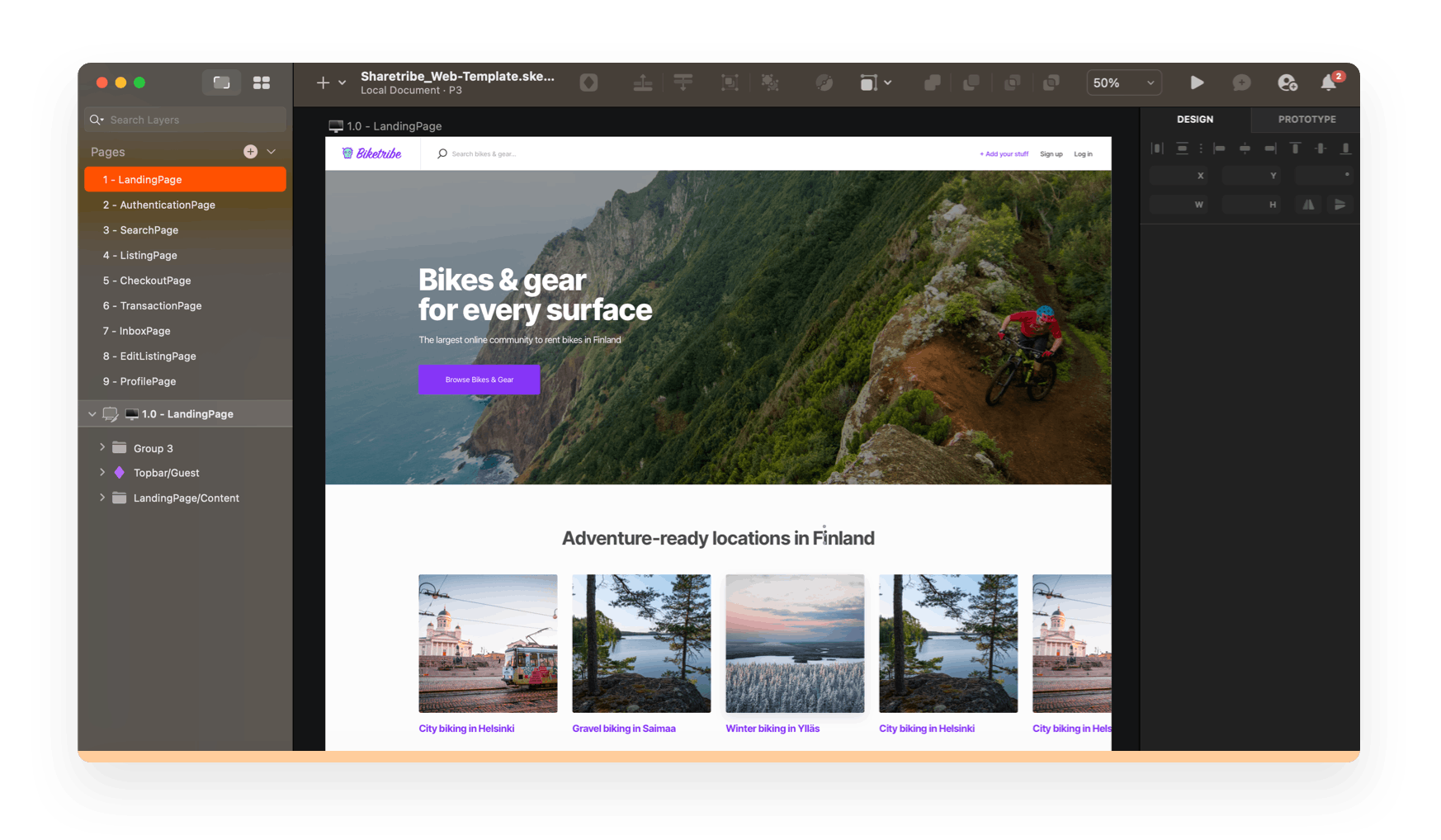
At this stage, you’ll need to decide which platforms you’re going to target. iOS? Android? Both? Something else? This is an important business decision where research into your target audience and their preferences helps.
Your choice of platform will impact your choice of tech stack.
For iOS, common technologies include
You’ll find lots of instructions and tips in Apple’s developer documentation.
For Android, the commonly used languages are
For Android, too, there’s comprehensive developer documentation available.
Alternatively, you could target both platforms at the same time and use React Native. You might already be familiar with React’s programming model from web development projects. If so, you might save considerable time in the mobile app development. You can take advantage of Sharetribe’s JavaScript SDK if you’re working with React Native.
Integrating your mobile app with the Sharetribe backend is as easy as calling any JSON HTTP API.
First, go to your Console and create a Client ID (instructions to enabling OpenID Connect login here). Use your Client ID to call the Sharetribe API. Note that some of our endpoints must be called from a secure context; these specific calls must be made from a server to prevent client-side exposure.
That’s it—your app’s interface now works with the Sharetribe backend features.
You’ve tested your app and are happy with the first version of your marketplace. Time to make it public!
Submitting a new app to an app store has specific guidelines depending on the platform. Here are the guidelines for iOS (App Store) and Android (Google Play Store). It may take anything from a few hours to several days for your app to be approved. Why not build a nice web landing page and a blog for your app and set up tracking in the meantime? Here are a few useful articles for how to track your key marketplace metrics and grow your marketplace.
Sharetribe powers over 1,000 marketplaces around the world. Here are some of our favorites - for more, check out some Sharetribe examples in our customer gallery or read our founder stories!
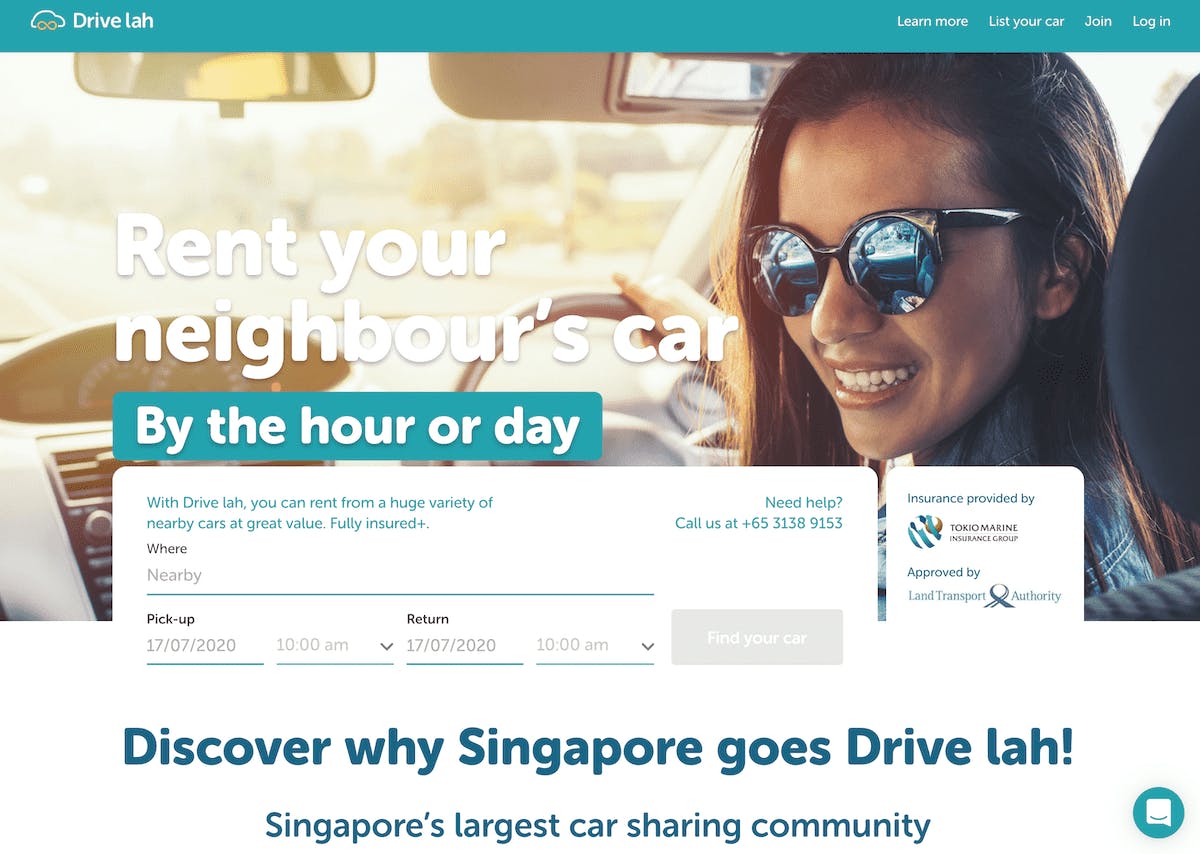
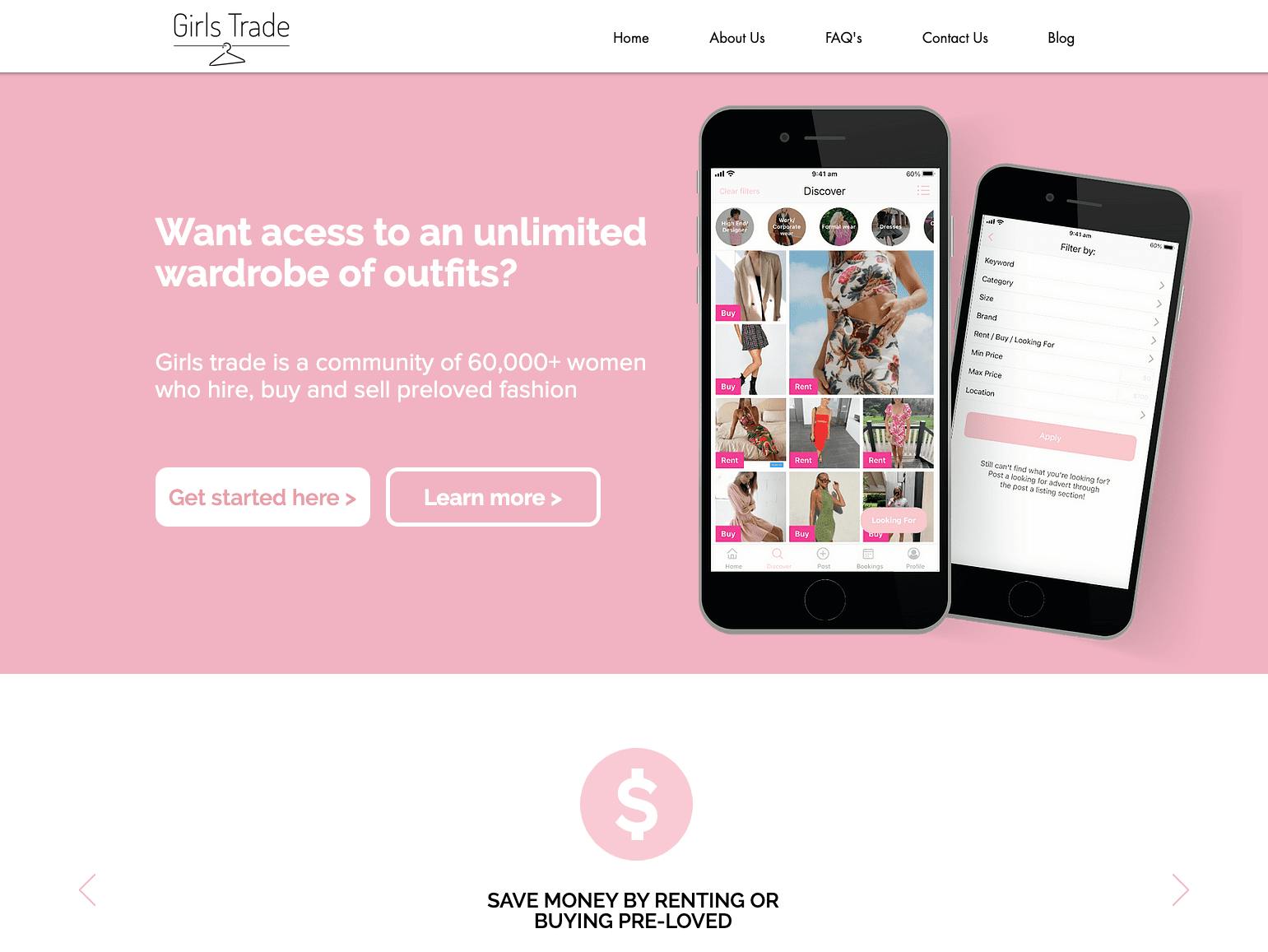
Girls trade is a community of 60,000+ women who hire, buy and sell preloved fashion.
The most important resource a founder has is their time and focus. Your competitive advantage comes from how you spend yours.
Building and maintaining the essential marketplace features is a huge investment with a poor return. The work is time-consuming, complicated, and sometimes extremely boring. The bulk of your budget will go to coding, debugging, and maintaining the marketplace basics when you could instead invest it in building unique features none of your competitors have.
What Sharetribe offers is a chance to spend your time and focus where they count. Skip the heavy lifting, launch your app 90% faster, and build things that help you differentiate and grow your business.
And if you ever get stuck, my colleagues and I are available in the Sharetribe developer Slack community and through email at hello@sharetribe.com.
Let’s get started.
Start your 14-day free trial
Create a marketplace today!
- Launch quickly, without coding
- Extend infinitely
- Scale to any size
No credit card required
